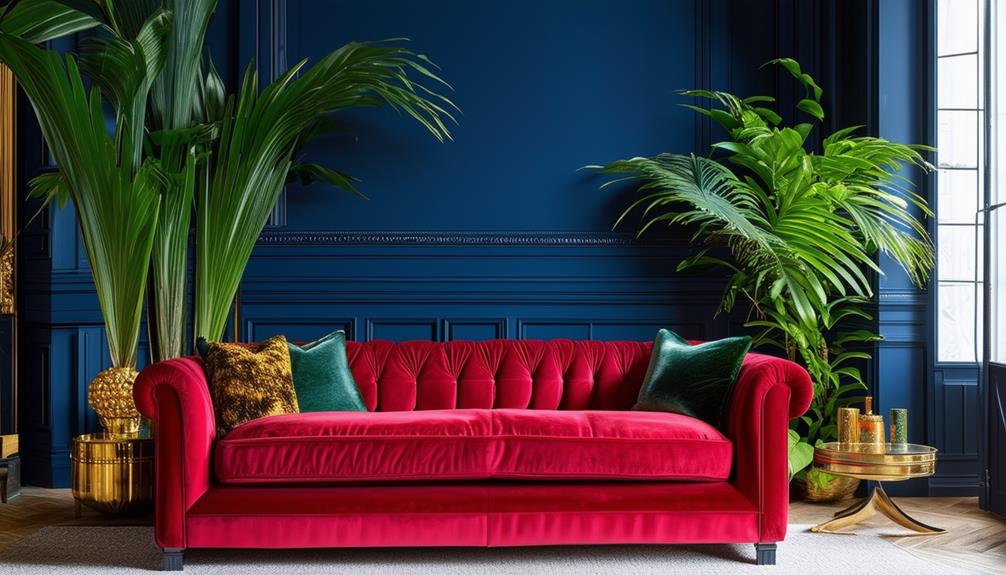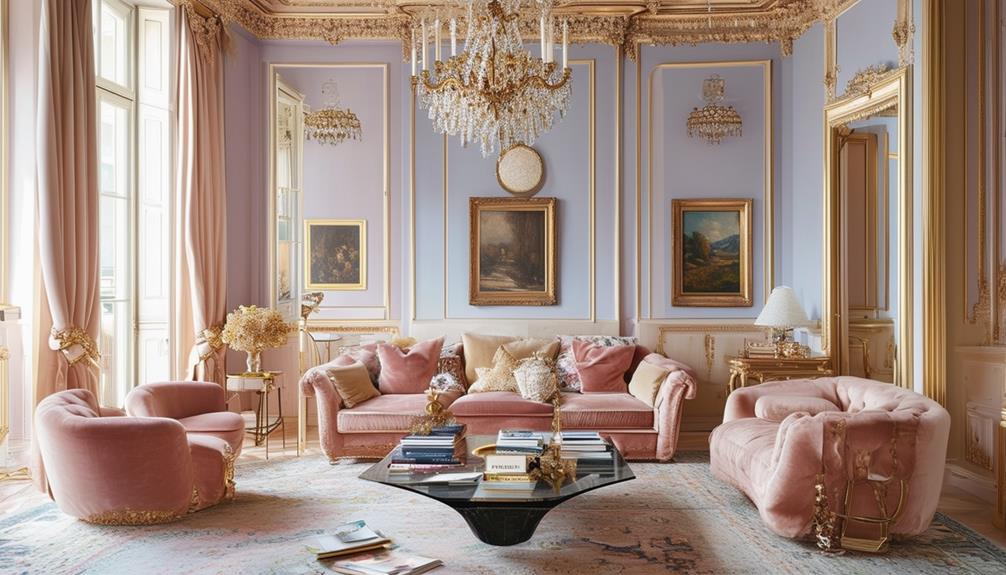French interior design frequently incorporates vibrant, rich hues to enhance the depth and personality of spaces. Parisian designers select these colors to complement both natural light and the environment.
They also employ neutral tones such as soft beiges and grays to establish a timeless foundation that makes spaces appear larger and more open. Through strategic seasonal color adaptations, interiors remain aligned with current trends and natural rhythms.
The integration of these elements merits further exploration.
Embracing Bold Colors

In French interior design, the strategic use of vibrant colors enhances spaces with both depth and elegance. Parisian designers, known for their bold color choices, create warm, sophisticated environments. Selecting vibrant hues adds personality and character to a home.
Each color choice is deliberate, designed to complement the surrounding environment and the natural light in the room, ensuring the colors remain impressive throughout the day. French design focuses on creating timeless, personal spaces rather than following transient trends.
Richly colored interiors tend to maintain their allure over time, making them a wise choice for lasting design appeal. Incorporating colors like deep blues, radiant reds, or emerald greens into a home makes a sophisticated statement and pays tribute to French artistic excellence. By adopting these colors, the ambiance of a home is significantly enhanced.
Neutral Tones Balance
Bold colors inject personality into a space, while neutral tones create balance, offering a serene environment that highlights vibrant colors effectively. In French interior design, neutral colors serve a strategic purpose, enhancing the aesthetic appeal of the space. Envision entering a room where soft beiges, ivories, and grays act as a canvas, allowing colors like rich blues and vivid greens to stand out prominently.
In French interior design, neutral tones extend beyond mere background elements. They foster openness and enhance natural light, contributing to a perception of increased space and warmth. This approach is evident in both chic Parisian apartments and expansive Provencal homes, where neutral colors help achieve a timeless elegance. These hues provide a flexible foundation, facilitating easy updates to decor or art without comprehensive redesigns.
In essence, the strategic use of neutral tones in French interiors not only complements bold colors but also optimizes space perception and light, ensuring adaptability and enduring style.
Beyond the Color Palette

In the realm of French interior design, the focus extends beyond mere color selection. Incorporating a variety of textures and optimizing the influx of natural light are pivotal for elevating a basic space into one of elegance.
Such strategies foster an ambiance that's both genuine and harmonious. These principles aren't only about aesthetics but also about functionality and comfort, ensuring a living space that's both practical and visually appealing.
Layering Textures Effectively
Layering textures enhances the functionality and style of interior spaces, particularly in French style decor. In these designs, the strategic use of velvet, silk, wood, and metal enriches the environment, making it both comfortable and visually appealing.
Parisian designers are known for their skill in combining these materials to create depth and interest, often incorporating contrasting textures to enrich the sensory experience of a space. Such combinations encourage tactile interaction, making the areas not only visually pleasing but also physically engaging.
This approach is central to the sophistication of French interior design, emphasizing the practical and aesthetic importance of texture in interior spaces.
Embracing Natural Light
In French interior design, natural light plays a crucial role in enhancing space and color. Designers often incorporate large windows, sheer curtains, and mirrors to maximize light flow, creating environments that are both bright and spacious. These elements not only illuminate the room but also highlight the color palette and textures present.
Skylights and light-colored flooring are additional strategies that increase natural light, making colors more vibrant and creating the illusion of greater space. Natural light is a key element in interior design, affecting color perception and contributing significantly to the aesthetic. Effective use of this light ensures a dynamic and cohesive interior space.
Textural Contrasts
French interior design often incorporates textural contrasts to enhance both the appearance and feel of a space. In a typical living room, the combination of various materials contributes to the transformation of the area's ambiance and style. For instance, velvet cushions on a leather sofa or silk drapes against painted walls offer a tactile experience that encourages interaction with the environment.
Designers in Paris are known for their skill in pairing contrasting textures, such as rough brick walls with smooth marble surfaces. These choices not only define the space but also emphasize the distinct properties of each material. Additionally, a soft rug on hardwood flooring can improve comfort and warmth, while rough wooden furniture alongside a plush sofa adds layers to the room, increasing its welcoming nature.
This approach not only elevates the visual dynamics of a room but also makes it more functional and comfortable. By focusing on the strategic use of textures, the living space becomes not only aesthetically pleasing but also practical and inviting.
Metallic Accents Integration

When incorporating metallic accents into a French-inspired interior, selecting the appropriate metallic tones is crucial for achieving elegance. Placement strategies are essential for maximizing the impact of these elements, ensuring they complement and enhance the space.
Additionally, mastering the art of mixing different metals can transform your decor from attractive to sophisticated. Prioritize the selection of metals, placement, and mixing techniques to optimize the aesthetic appeal of your interior design.
Choosing Ideal Metallic Tones
When selecting metallic tones for a French-themed interior, consider the interaction between these finishes and both natural and artificial light. Metallic elements, essential in modern French decor, reflect light and influence the mood of a space.
Integrating metallic elements, such as silver or gold, aligns with French design traditions that emphasize elegance. These elements are effective when combined with distinctive blue tufted couches, typical of Parisian style. The contrast between metallic tones and rich colors creates a refined atmosphere that embodies the luxury of French decor.
Placement Strategies for Impact
Consider the placement of metallic accents in interior design; their precise location significantly enhances the interaction of light and color within a room.
In French design, these accents are strategically positioned to complement contemporary forms and enrich color schemes.
For example, a blue tufted couch can be enhanced by metallic elements that introduce luxury and a modern aesthetic.
These accents, found in both sculptural decor and furniture, are used to create visual contrasts that are captivating. They complement rich colors, adding layers of sophistication.
Such deliberate integration transforms a beautiful space into an exceptional one, combining glamour with functionality.
Mixing Metals Seamlessly
Parisian designers excel in integrating metallic accents into interiors, enhancing both elegance and visual harmony. They adeptly combine modern forms with rich colors, achieving a sophisticated aesthetic.
Strategically placed metallic elements, often sculptural, complement architectural features in French interiors, balancing rich colors and enhancing spatial appeal. For example, a blue tufted couch with metallic touches introduces a vibrant, refined flair characteristic of Parisian style.
Incorporating metallics transcends mere decoration, adding a layer of luxury and timeless charm emblematic of French design.
Influence of Natural Light

Natural light significantly influences the ambiance of interiors in France. In French homes, the design process strategically incorporates natural light. Large windows allow light to flow into spaces, directly affecting color choices. Colors dynamically interact with the varying light throughout the day, altering the atmosphere continually.
Parisian designers excel in optimizing natural light to enhance the visual appeal of interiors. They analyze how sunlight affects various materials and surfaces, which adds depth and texture to spaces. This interaction between light and color can make small areas appear more spacious and airy, or give a warm feel to larger spaces based on the light's intensity and direction.
Furthermore, techniques such as using reflective surfaces or choosing translucent fabrics maximize natural light's impact. These methods ensure that light actively enhances the room's ambiance, making the environment vibrant and welcoming. In such environments, colors appear more vivid and textures seem richer.
Key Points:
- Strategic use of natural light is integral in French interior design.
- Large windows facilitate the dynamic interaction of light and color, influencing space perception.
- Parisian designers use sunlight to enhance material and surface textures.
- Techniques like reflective surfaces and translucent fabrics optimize natural light.
- Enhanced natural light makes colors vivid and textures rich, enhancing the overall ambiance.
Seasonal Color Adaptation
In Paris, interior designers update their color palettes seasonally to ensure environments reflect current trends. Exploring design in Paris reveals that seasonal color shifts are strategic elements of local interior aesthetics.
In spring, designers opt for pastels and light hues such as soft lavender, pale pink, and serene blues. These colors introduce a sense of renewal and freshness in homes, aligning with outdoor blossoming. This approach serves as a transition from the darker tones prevalent in winter.
By autumn, color palettes change to include rich, earthy tones like burnt orange, deep red, and golden yellows. These colors foster a cozy atmosphere, suitable for the shorter, cooler days. Parisian designers strategically use these autumnal colors to enhance warmth and comfort in preparation for colder weather.
This methodical color adaptation ensures that interior spaces remain stylish and synchronized with the natural seasonal cycle. Adopting this approach can add Parisian elegance to any space.

